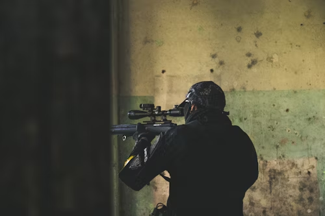Emergency Management Training
Emergency Management Training
Emergency management training is a comprehensive program designed to equip staff, first responders, and leadership with the necessary knowledge and skills to effectively prevent, prepare for, respond to, and recover from a wide range of disruptive events, from natural disasters to technological failures and security threats. The training typically utilizes a variety of methods, including classroom instruction, tabletop discussions, and full-scale simulation drills, to familiarize participants with emergency response procedures, incident command systems, critical communication protocols, evacuation routes, and specific individual roles and responsibilities. The ultimate purpose of this continuous training and exercise cycle is to test and validate existing plans, identify weaknesses, and build a coordinated, practiced organizational muscle memory that ensures the safety of personnel and the rapid return to normal operations. The IMS team is comprised of industry leaders and educators who have extensive experience designing and facilitating a wide range of training and education tools and resources.
Incident Management Team (IMT) training is a specialized program that focuses on developing a dedicated group of personnel to assume command, coordinate resources, and effectively manage the operational and strategic aspects of a complex or prolonged organizational crisis. This training is rooted in the Incident Command System (ICS), teaching participants specific roles and responsibilities within a structured hierarchy to ensure clear communication, streamlined decision-making, and accountability. The IMT learns to assess situations, set incident objectives rapidly, develop Incident Action Plans (IAPs), manage internal/external communications, and ensure unified efforts to stabilize incidents, protect organizational assets, and achieve successful resolutions.
Incident Management Team
Command Center
Command Center training equips crisis staff with the structure and skills needed to operate a central coordination facility during a major event effectively. It involves mastering the technological tools for real-time data aggregation, situational awareness, and collaborative display on video walls. Trainees learn standardized procedures, communication protocols, and their specific roles (e.g., Incident Commander, Liaison Officer) within a structured system like ICS. The core focus is on rapid, informed decision-making and developing Incident Action Plans (IAPs) to manage and resolve crises efficiently. This training is validated through realistic, scenario-based simulation exercises to test team coordination under pressure.
Executive Leadership Training
This training prepares senior leaders to effectively navigate crises by enhancing their strategic decision-making, risk management, and crisis communication skills. Through case studies and simulations, participants develop the ability to lead their organizations in building resilience and ensuring effective responses to emergencies. Key functions covered include presenting a clear, synthesized common operating picture; managing the flow of critical information; ensuring continuity of government/business operations; and managing external affairs.
Hazardous Materials PPE Donning/Doffing
Hazardous Materials (HazMat) Personal Protective Equipment (PPE) training is critical for personnel exposed to chemical, biological, or radiological hazards. This OSHA-mandated training focuses on selecting the appropriate protective ensemble based on the hazard, concentration, and potential for exposure, utilizing the EPA's four levels of protection, which range from Level A (highest respiratory and skin protection with a totally encapsulating suit) to Level D (minimal work uniform). Training covers proper donning and doffing procedures to prevent cross-contamination, understanding the limitations and maintenance of equipment like respirators and chemical-resistant suits, and ensuring a correct fit for effective protection from various hazards.
High-Consequence Pathogens
This essential training prepares staff to manage infectious disease outbreaks with high-consequence pathogens. It covers the critical "Identify, Isolate, Inform" framework and strict Personal Protective Equipment (PPE) protocols. Participants master the proper donning, doffing, and decontamination of specialized PPE (e.g., fit-tested respirators, impermeable gowns) to prevent transmission. The course emphasizes isolation procedures, environmental controls, and a coordinated response plan to protect occupants and staff.
Active Shooter/Assailant
Active Shooter/Assailant training focuses on preparing staff and securing occupants during a violent threat. The core concept is Run, Hide, Fight, emphasizing swift evacuation, secure lockdown, or, as a last resort, self-defense. This essential training covers recognizing warning signs, developing facility-specific lockdown procedures, and effective communication with law enforcement. The goal is to maximize survival and minimize harm to occupants and personnel within the community.
Casualty Care Group
This training focuses on the Hospital Incident Command System (HICS) Casualty Care Group, a vital component of the Operations Section during a disaster. Participants learn to manage the surge of patients by organizing triage, treatment, transport, and discharge efforts within the facility. The curriculum emphasizes establishing clear patient flow, allocating resources effectively, and coordinating acute and continuous care to sustain services during a mass casualty incident or facility-wide emergency. It ensures a standardized, scalable medical response that integrates seamlessly with the overall command structure.
START/JumpSTART
S.T.A.R.T. and JumpSTART Triage Training equips staff to quickly and accurately sort casualties during a mass casualty incident (MCI). S.T.A.R.T. (Simple Triage and Rapid Treatment) is used for adults, rapidly categorizing them into four priority groups (Immediate, Delayed, Minor, Deceased) based on respirations, perfusion, and mental status. JumpSTART is the specialized pediatric adaptation, ensuring appropriate triage for children. This hands-on training is vital for organizations to prioritize treatment and manage the immediate aftermath of a disaster, maximizing survival rates by directing limited resources effectively.
STOP THE BLEED
Stop the Bleed training is a crucial public health campaign designed to empower bystanders to save a life during a bleeding emergency before professional help arrives. Since a person can bleed out in less than five minutes, immediate action is vital. This hands-on course teaches essential life-saving techniques to control severe bleeding resulting from accidents or disasters. Participants learn to recognize life-threatening hemorrhage and apply three core methods: applying direct pressure to a wound, packing deep wounds with gauze or cloth, and correctly applying a tourniquet to an injured limb.
Annual Staff Education Curricula
Annual staff emergency management training is a program designed to ensure all personnel are prepared to protect lives and maintain operations during a crisis. Utilizing an all-hazards approach, this training covers facility-specific risks, ranging from natural disasters (like fires or floods) to human-caused incidents (such as active threats or utility failures). The curriculum focuses on the four core elements of preparedness: mitigation, preparedness, response, and recovery. Staff are trained on the emergency operations plan, proper evacuation and "shelter-in-place" procedures, and the use of emergency equipment to ensure a coordinated, swift, and effective response.
Other Services
In addition to the detailed services already described, IMS can provide a broad range of other services through access to a pool of subject matter experts that have specific experience. Examples include, but are not limited to: Infection Prevention, Regulatory Compliance, Security Assessments, Technical Writing, etc.
Planning
The development of strategies and procedures to effectively prepare for, respond to, and recover from disasters or crises, ensuring the safety of people, property, and operations.
Training
Provides individuals and organizations with the knowledge and skills necessary to effectively respond to crises, implement emergency plans, and ensure coordination during disasters or emergencies
Leadership
Guiding and coordinating teams during crises, making critical decisions under pressure, and ensuring effective communication and resource allocation to minimize impact and facilitate recovery
Drills & Exercises
Exercises simulate real-world disaster scenarios to test and refine response plans, enhance coordination among teams, and improve decision-making and communication under pressure
Already In A Crisis?
Need An Emergency Plan, Services, or Plan of Correction Right Away?










